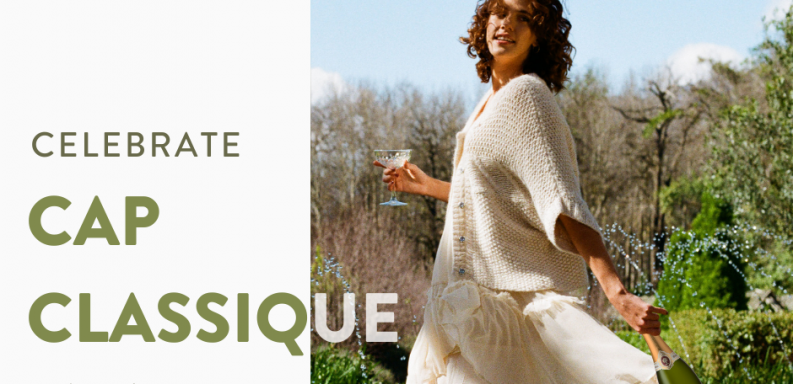Celebrate Cap Classique Day - A peek behind Boschendal’s bubbly history
By Admin | 29th August 2023
This Friday, we celebrate Cap Classique Day - a great excuse to pop a cork and learn more about South African Cap Classique.
Our friends at Boschendal have very kindly sent us a little more information from Danielle Coetsee, Boschendal Cap Classique Winemaker, about the history behind their bubblies that have roots that run as deep as Cape agriculture itself.

"In 1981, Boschendal Estate became the second producer of Cap Classique in South Africa, meticulously following the méthode champenoise technique under the careful guidance of then Cellar Master Achim von Arnim. In 1992, the term ‘Methode Cap Classique’ (today shortened to simply Cap Classique) was coined. In the same year, the Cap Classique Producers Association was formed, with the goal to promote quality and set minimum standards for the production of all Cap Classique countrywide.
The first bottled Boschendal bubbly was a vintage 1981 Brut. Since then, Boschendal’s Cap Classique portfolio has diversified. Today, it includes three Non-Vintage Cap Classique wines: Boschendal Brut NV, Boschendal Brut Rosé NV and Boschendal Luxe Nectar (a Demi-Sec). Across this range, the signature house-style results in freshness, elegance and a depth of flavour.
Of course, the crème de la crème of Boschendal’s bubbly offering are the two Prestige Cuvées Vintage wines. This is the apex of our collection where only the finest vintages result in their release. The Prestige Cuvées include: Boschendal Grand Cuvée Brut (a blend of Pinot Noir and Chardonnay) and the acclaimed vintage Blanc de Blanc Jean Le Long. The Boschendal Jean Le Long Vintage Brut won Best South African Cap Classique in 2019 and is made by utilising extended lees aging, resulting in a late disgorged Cap Classique.
As a 100% Chardonnay, the Boschendal Jean Le Long Vintage Brut allows for an extended time on lees with a minimum contact period of 60 months. The result is a Cap Classique that tantalises the senses with its fresh, cool climate acidity and beautifully rounded yet equally complex structure. Interestingly, the Jean Le Long 2009 Brut had an even lengthier time on lees, due its incredible consistency and freshness. The result is an opulent Cap Classique with notes of brioche and lemon cream and a smooth yet delectable mousse on the palate. The Jean Le Long is a true testament to Boschendal’s pursuit to craft the ultimate bubbly.
The force majeure felt by all those who have worked with the Boschendal Cap Classique to maintain the attention to detail and consistently look for slight, yet noteworthy methods in which to improve each vintage and non-vintage blend or single cultivar wine, is tangible. This has been my experience in working with the Cap Classique wines from this historic estate. There is a loyalty and obligation to all those that have walked the Boschendal Estate soils before you, to pay homage to the ground-shakers, rule-breakers and revolutionaries that have had a part in the legacy that is Boschendal wines".
But how do you craft the perfect Cap Classique?
"In France, they call it Champagne. In South Africa, we call it Cap Classique. Both styles use the same traditional methods but with very distinctive characteristics. As 2023 marks the 52nd anniversary of the Cape’s Cap Classique category and Boschendal’s 42nd anniversary of producing this vibrant elixir, let’s honour this remarkable milestone by exploring how this unique sparkling wine is made.
Have you ever wondered where the characteristic ‘Pop!’ and resulting bubbles come from when opening a bottle of Cap Classique? As a ‘bottled fermented wine’, Cap Classique is made using the age-old méthode champenoise technique - attributed initially to inventor Dom Perignon in the late 1600s. In short, the grapes are pressed and fermented in stainless steel tanks - much like traditional wine. However, the difference comes in that once the base wine is bottled, the winemaker adds a measured combination of sugar and yeast (called the liqueur de tirage) to kickstart a second fermentation process - right in the bottle!
The reason the base wine is sweetened is to ensure that the yeast mixture has enough ‘food’ and nutrients to survive the increasing pressure. The by-products of most sugar-based fermentations are heat and carbon dioxide. As the bottle volume under the crown cap is 750ml, the heat created from the fermentation is not that significant (although at Boschendal, we still complete bottle fermentation in a temperature-regulated storage area). However, the increase in pressure from carbon dioxide production can be significant, producing 6 to 8 bars of pressure.
Since the bottle is tightly sealed and the second fermentation takes place within it, there’s nowhere for the gas to escape – so it is reabsorbed into the liquid until the cork pops, and it gets a chance to sparkle! The result is a Cap Classique with approximately 50 million bubbles per bottle, which creates the beloved ‘fizz’ effect on the wine and resulting and sought-after ‘mousse’ sensation on the palate. While Cap Classique’s production is time-consuming and a trial of devotion and patience, it is by far the most rewarding category of wine to produce - and no doubt the most exhilarating to consume!
Salute!"
We'll drink to that. Thank you for all the insights Danielle!
Below are some stockists for the Boschendal wines:
